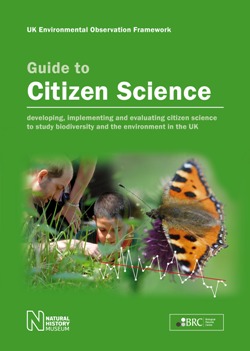A new practical guide on how to develop, implement and evaluate citizen science projects to monitor the UK’s environment was published on 23rd November and launched at the NBN Conference. The guide is based on conclusions from a comprehensive report reviewing more than 200 citizen science projects from the UK and around the world.
Scientists from the NERC Centre for Ecology & Hydrology and the Natural History Museum in London were commissioned by the UK Environmental Observation Framework (UK-EOF) to undertake a review of citizen science. The aim of the project “Understanding Citizen Science and Environmental Monitoring” was to learn lessons from past citizen science projects. The report and guide are particularly timely because there is growing interest in using citizen science, an increasingly valuable approach to scientific discovery, for environmental monitoring purposes.
Citizen science can broadly be defined as the involvement of volunteers in science. The UK-EOF project reviewed 234 projects ranging in scale from small one-off local surveys, such as a bioblitz in a local park, to large scale long-term programmes, such as the UK Butterfly Monitoring Scheme. The project team studied the motivations of volunteers, held structured interviews with users of citizen science and environmental monitoring data, and looked at how such projects help meet policy needs.
The practical guide accompanying the full project report shares the good practices found during the review process, making suggestions on how to plan, carry out, and evaluate citizen science projects to provide benefits for both participants and potential data users.
Project leader Dr Helen Roy from the Biological Records Centre at the NERC Centre for Ecology & Hydrology said, “It has been fantastic to have the opportunity to review such a wide range of citizen science projects. Our work shows the high value of citizen science to research, policy and practice, as well as its importance in connecting thousands of people to their environment across the UK, and the wider world.”
Professor Doug Wilson, Head of Scientific and Evidence Services in the Evidence Directorate at the Environment Agency and chair of the UK-EOF Management Group said, “Citizen science has a vital role in scientific research and education, and the potential to help meet some of the challenging demands of environmental monitoring at the national scale. This gives citizen science a clear relevance to government policy across the UK. The easily accessible Guide, along with the supporting Report, will provide a fabulous resource for anyone interested in working with volunteers in citizen science.”
Lead author of the practical guide Dr John Tweddle, from the Angela Marmont Centre for UK Biodiversity at the Natural History Museum, said, “Volunteer participation in the observation of nature and wider environmental monitoring has a long and illustrious history, especially in Britain. It’s a fun and rewarding pastime that plays a huge role in improving our scientific understanding. Our Guide aims to support anyone with an interest in developing their own citizen science project – and new communication technologies, like mobile phone apps and environmental sensors, mean that it has never been easier to get involved.”
 The project concluded that:
The project concluded that:
• Environmental-based citizen science has a wide scope. For centuries citizen scientists have monitored a broad range of plants, animals and fungi (80% of the projects reviewed involved biodiversity) as well as contributing data on weather and the wider environment using many varied approaches (from citizen-led projects with local community groups to, more commonly, scientist-led mass participation initiatives that are open to all sectors of society).
• The use of recent technological developments is revolutionising citizen science – for example the use of online recording, such as iRecord, and smartphone apps, such as PlantTracker.
• Data quality from citizen science can be excellent, even though this is not yet recognised by all researchers and policymakers – citizen scientists working alongside professional scientists or using appropriate quality assurance and validation processes provide data of a very high standard and additionally have the capacity to provide data across large geographic areas and over long timescales.
• Citizen science is a very cost-effective way of collecting environmental data. During one year alone, volunteer observers for biodiversity surveillance in the UK were estimated to contribute time in-kind worth more than £20 million. However, despite relying on volunteers, citizen science is not free. The analysis carried out showed that projects providing data relevant to policy development typically have annual running costs of between £70k and £150k, spent, for example, on website or smartphone app development, publicity material, data management and event costs, on top of the in-kind contribution of volunteers.
• There is potential to make considerably more use of citizen science than is currently the case. A good example is the surveillance and monitoring of invasive non-native species building on the work of existing projects such as the GB Non-Native Species Information Portal (GB-NNSIP) which already encourages people to submit records of species of concern to an online alert system.
You can download the guide here
The full report can be downloaded (from the UK-EOF, CEH and NHM websites) and can be distributed for non-commercial purposes.
